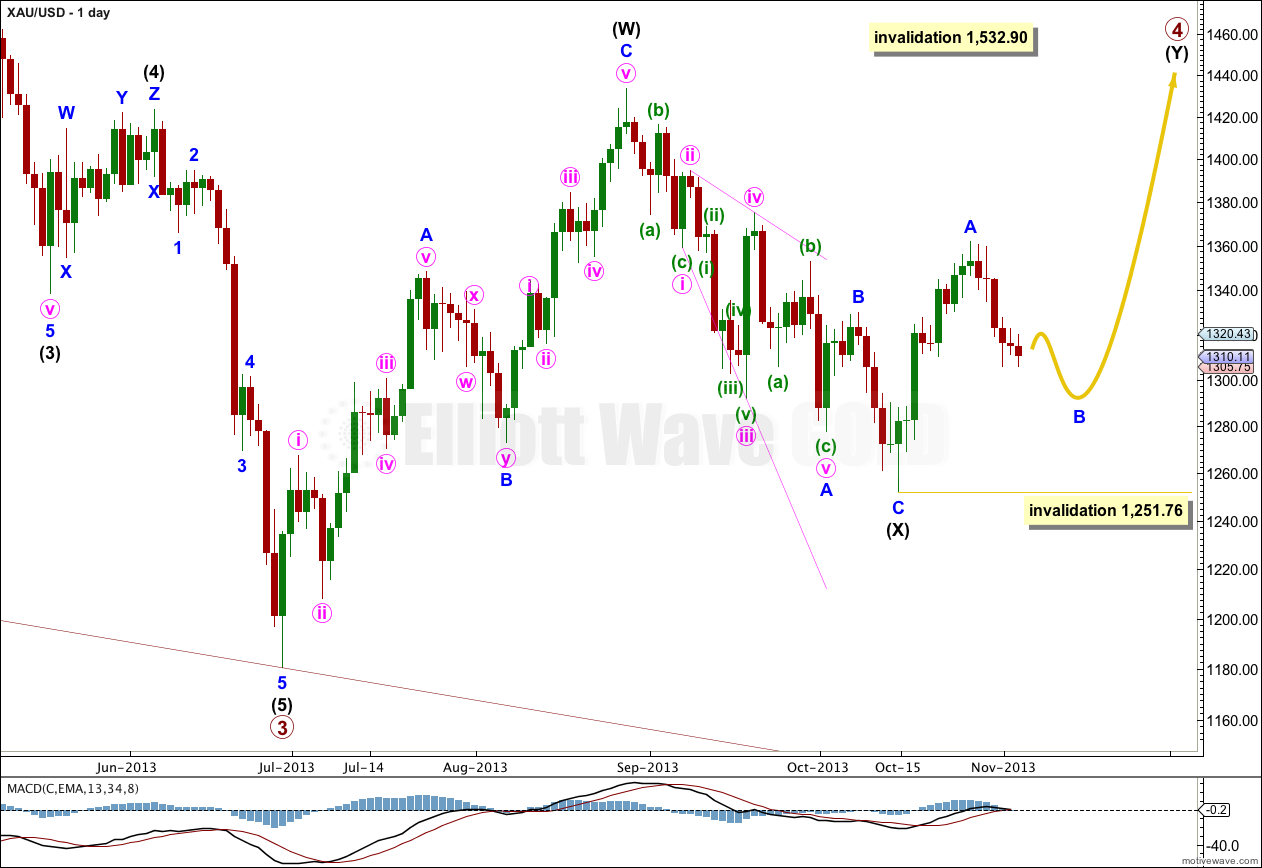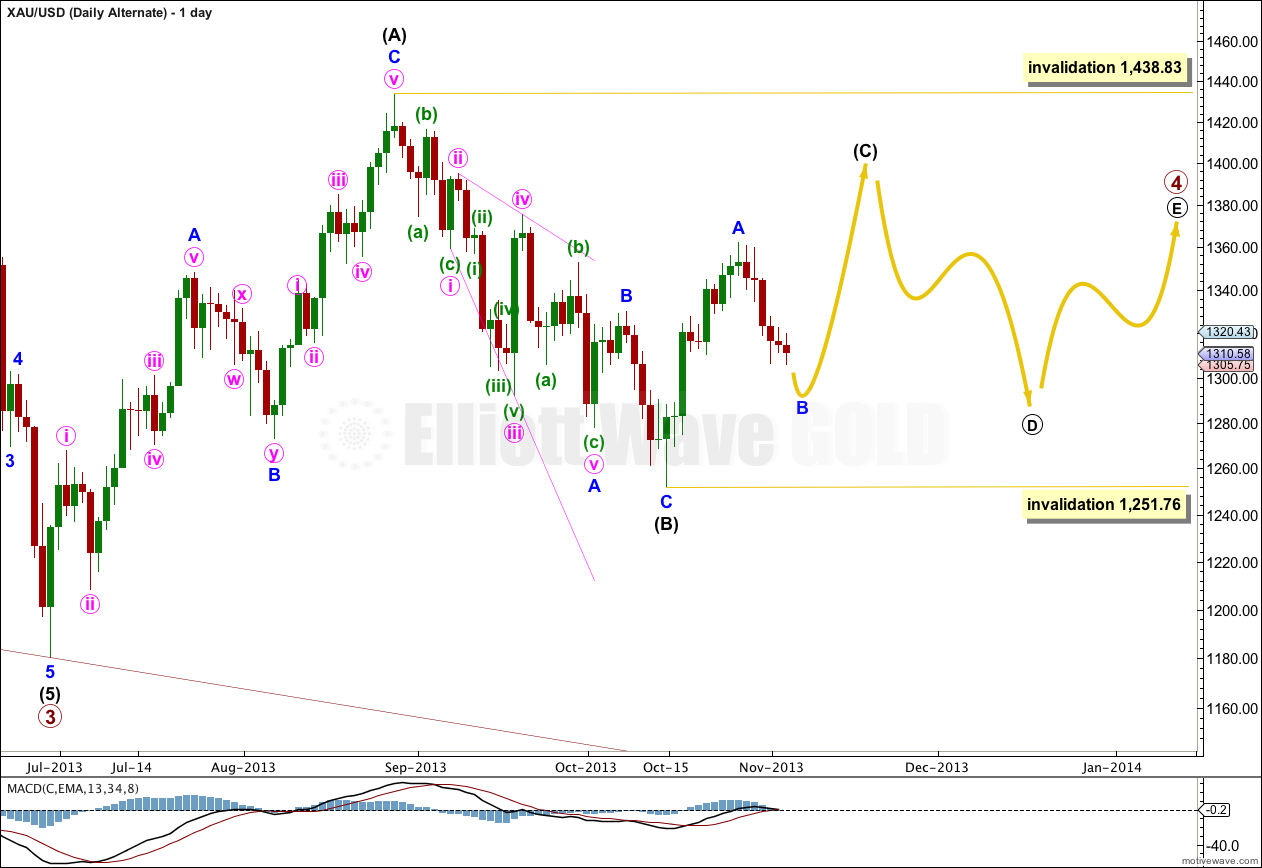Yesterday’s analysis expected downwards movement to a minimum of 1,308 before upwards movement. Price moved lower as expected, reaching down to 1,305.97.
The corrective structure of minute wave b is still incomplete.
Click on the charts below to enlarge.
The structure for primary wave 4 cannot be a flat correction, because what would be the B wave is well less than 90% of what would be the A wave. That is why I have labeled it as a double.
Because intermediate wave (X) is quite shallow I would expect primary wave 4 is most likely a double zigzag rather than a double combination. Double combinations move price sideways and their X waves are usually deeper than this one is. Double zigzags trend against the main direction, and their purpose is to deepen a correction when the first zigzag did not take price deep enough. So I will be expecting intermediate wave (Y) to subdivide as a zigzag and to take price comfortably above 1,433.83. It should last about 35 to 45 days or sessions in total.
Within the zigzag of intermediate wave (Y) minor wave B may not move beyond the start of minor wave A. This wave count is invalidated with movement below 1,251.76.
The structure of minuette wave b is closer to completion, but it is still incomplete.
Minuette wave (b) is a 101% correction of minuette wave (a) which indicates a regular flat is unfolding for minute wave b. Regular flats most commonly have C waves which are close to equality with A waves. I would expect minuette wave (c) to overshoot the parallel channel slightly.
Minuette wave (b) is now a complete zigzag. Within it subminuette wave c is 0.71 short of 1.618 the length of subminuette wave a.
The final wave upward of minuette wave (c) needs to unfold as a five wave structure. Minuette wave (c) is highly likely to make a new high above the end of minuette wave (a) at 1,322.68 to avoid a truncation and a very rare running flat. At 1,323 minuette wave (c) would reach just over equality with minuette wave (a).
Alternate Daily Wave Count.
It is possible that a large contracting triangle is unfolding for primary wave 4, but it has a lower probability than the main wave count. Double zigzags and combinations are in my experience more common structures than triangles. However, triangles are not rare, they are just less common.
Triangles are very tricky structures to analyse. I normally only consider them when they show themselves clearly, which is close to the end of the structure.
At this stage within a possible triangle only waves A and B would be complete. One of the five subwaves should subdivide into a double zigzag, be more time consuming, and have deeper corrections than the other subwaves.
Within a contracting triangle intermediate wave (C) may not move beyond the end of intermediate wave (A), and intermediate wave (D) may not move beyond the end of intermediate wave (B).
Within a barrier triangle intermediate wave (D) should end about the same level as intermediate wave (B), which in practicality means it may move slightly lower than 1,251.76. As long as the B-D trend line remains flat.
The triangle is invalidated with any movement above 1,438.83, or with much movement below 1,251.76.




ok thanks
i have seen 3 pictures, today market is not crossing 1321 level, so what do you suggest should i remain in buy positions? i think stoploss should be 1306.
You have misunderstood what this service does. I provide analysis only, I am telling you what my opinion is on where the market will move to next based upon the Elliott wave principle. I cannot tell you how to trade.
This service is best used in conjunction with your own analysis. Use my Elliott wave analysis as one tool in your decision making tool kit.
This is not a signal service, nor is it investment advice. It is Elliott wave analysis only.